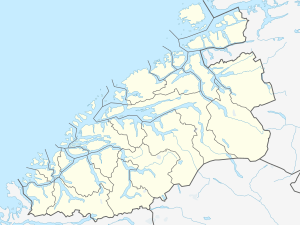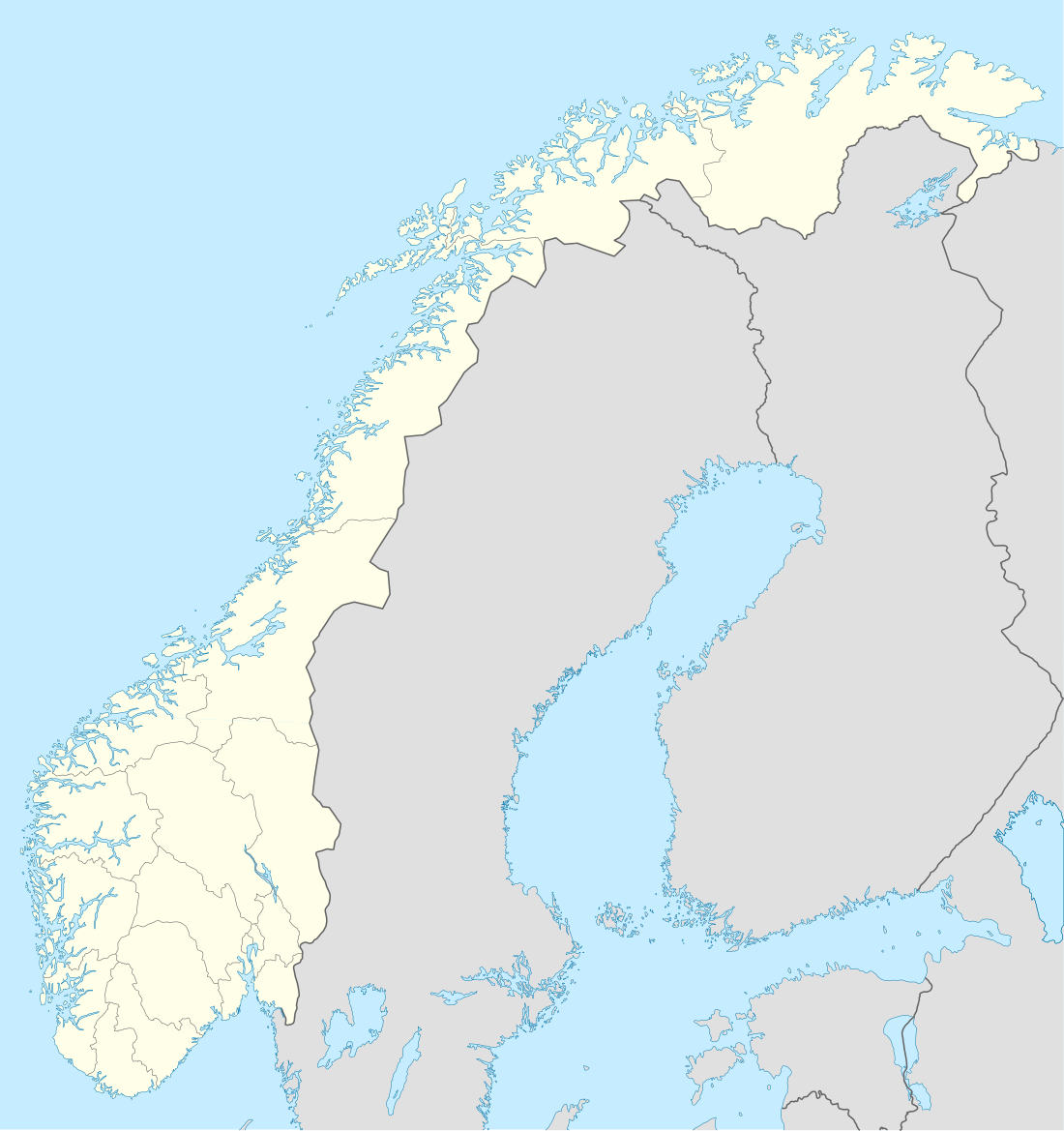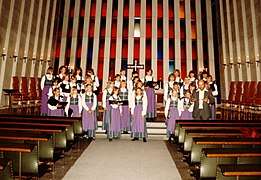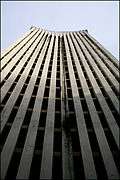Kirkelandet Church
Kirkelandet Church (Norwegian: Kirkelandet Kirke) is a parish church of the Church of Norway in Kristiansund Municipality in Møre og Romsdal county, Norway. It is located on the island of Kirkelandet in the town of Kristiansund. It is the church for the Kristiansund parish which is part of the Ytre Nordmøre prosti (deanery) in the Diocese of Møre. The white, concrete church was built in a modern, rectangular style in 1964 by the architect Odd Østbye. The church seats about 550 people.[1][2]
| Kirkelandet Church | |
|---|---|
| Kirkelandet kirke | |
View of the church | |
 Kirkelandet Church Location of the church  Kirkelandet Church Kirkelandet Church (Norway) | |
| 63.1144°N 7.72583°E | |
| Location | Kristiansund Municipality, Møre og Romsdal |
| Country | Norway |
| Denomination | Church of Norway |
| Churchmanship | Evangelical Lutheran |
| Website | Official Website |
| History | |
| Status | Parish church |
| Founded | 1709 |
| Consecrated | 1964 |
| Architecture | |
| Functional status | Active |
| Architect(s) | Odd Østbye |
| Architectural type | Rectangular |
| Groundbreaking | 1961 |
| Completed | 1964 |
| Specifications | |
| Capacity | 550 |
| Materials | Concrete |
| Administration | |
| Parish | Kristiansund |
| Deanery | Ytre Nordmøre prosti |
| Diocese | Møre |
| Clergy | |
| Dean | Gerd Anne Aarset |
| Pastor(s) | Tormod Sikkeland |
The church is also the seat of the Ytre Nordmøre prosti (deanery), and Gerd Anne Aarset is the Dean who is seated here. Tormod Sikkeland is the pastor of the congregation.
Design
The church is reckoned as one of the most daring "modern" church buildings in Norway. The architect Odd Østbye created a building which breaks with all traditional church architecture. The architectonic idea behind the church is "Quartz in roses", meaning that the church is shining as a glowing quartz among the roses.[3]
The church was nominated as the representative from Møre og Romsdal county as the "Building of the Century 1905-2005" (Århundrets byggverk 1905–2005) for Norway.
History
The first church in Kristiansund was built in 1709. This church only stood for 15 years before being struck by lightning and burning to the ground. In 1725, a new church was completed on the same site. This building was a cruciform design with an onion dome. On 19 December 1872, the Kristiansund City Council decided that the church parish should be divided and a new church was to be erected on the island of Kirklandet and the old church building would be moved to the neighboring island of Nordlandet. Previously, the church had been known as Kristiansund Church, but with two churches, they would get new names. The new church on Kirkelandet would be known as Kirkelandet Church and the old church that would be moved to Nordlandet would be known as Nordlandet Church. The new Kirkelandet Church was designed by Henrik Thrap-Meyer and it was built from 1875–1878 and it was consecrated on 18 September 1878. It was a neo-Gothic long church with 1200 seats. It was built on Lyhshaugen (a nearby hill named after merchant Lyhs). Budget overruns and large municipal expenditures in general meant that the Nordlandet project was postponed, despite the fact that land was purchased. The old church stood for a few years after the new one was completed before the old church was demolished in 1884. Years later, in 1914, the new Nordlandet Church was finally constructed. During World War II, the Germans bombed the town of Kristiansund in April and May of 1940 and many buildings were destroyed and burned including Kirkelandet Church. After the war was over, there was a lot of rebuilding all over Norway, and the Kirkelandet Church eventually was rebuilt in 1964, making this the fourth church building to stand on the island.[4]
Media gallery
- Exterior back
 Interior front
Interior front Interior
Interior Close up of the exterior
Close up of the exterior
See also
- List of churches in Møre og Romsdal
References
- "Kirkelandet kirke". Kirkesøk: Kirkebyggdatabasen. Retrieved 2019-05-19.
- "Oversikt over Nåværende Kirker" (in Norwegian). KirkeKonsulenten.no. Retrieved 2019-05-19.
- "Kirklandet Church - Norway`s most daring modern church". VisitNorway.com. Retrieved 2010-11-21.
- "Kirkelandet kirke" (in Norwegian). Norske-Kirker.net. Retrieved 2019-05-19.